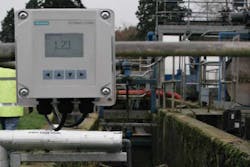CASE STUDY: Ultrasonic Level Controller Optimizes Influent Measurement In Wastewater Treatment Application
DIN rails, pipes, or walls. (Photo courtesy of Siemens Industry Inc.)
Mid-morning on a hillside near Carluke, Scotland. If you didn’t know any better, you might not realize that you were standing in the middle of a wastewater treatment facility.
Green grass waves in the light breeze, as 6.8 megaliters (1.8 million gallons) of influent flow daily through a mossy covered channel during dry weather–increasing to nearly 41 megaliters (10.8 million gallons) during storm conditions. Black crows squawk as they ride the rotating trickling filter like excited children on a slow-moving merry-go-round.
Scottish Water operates thousands of wastewater treatment facilities across the country–both small, like this one located about 32 kilometers (20 miles) south of Glasgow, and much larger. In total, the company collects and treats more than 864 megaliters (228 million gallons) of wastewater from households, businesses, and industry every day. Continuous improvement is a priority for the company–in everything from energy saving initiatives to equipment upgrades.
Challenge
Wastewater from nearby towns and villages flows to Mauldslie STW, first streaming through the primary cleaning area. Influent runs through open channels on its way to chemical treatment. A Siemens Echomax XRS-5 ultrasonic transducer, mounted above the influent flume and coupled with a HydroRanger 200 level controller, monitors head level in the channel and uses that information to calculate flow data.
Level measurements from the influent flume are important for day-to-day operations and for environmental reporting. Controllers provide Scottish Water’s operations with a continual flow of information to determine chemical dosing and treatment quantities. Higher accuracy means better process control, which translates into long-term cost savings for Scottish Water and its customers. As well, monitoring influent and effluent helps to determine a wastewater facility’s performance and any future upgrades or expansions.
Level measurements reported to governmental monitoring agencies must therefore be highly accurate. The HydroRanger 200 was working well in this open-channel monitoring application, but improved accuracy is always desirable for wastewater treatment facilities. Also, some advanced programming required frequent use of the manual. Scottish Water was interested in trying Siemens’ newest ultrasonic controller to compare its features with those of the older device.
Solution
The newly introduced SITRANS LUT400 is a good fit for the water/wastewater industry. The SITRANS LUT400 series features one milimeter (0.04-inch) accuracy, intuitive operation, and a host of other customer-driven features. Three models make up the series: SITRANS LUT420 Level and Volume Controller, SITRANS LUT430 Level, Volume, Pump, and Flow Controller, and SITRANS LUT440 High Accuracy Open Channel Monitor (OCM), which also provides a full suite of advanced level, volume, and pump controls.
For monitoring levels in the influent flume, Scottish Water operators installed a SITRANS LUT440. The controller is well suited for outdoor applications. Installation and setup was fast and easy, and there was no need to replace the existing Echomax transducers. Using the Quick Start Wizard, operators programmed the SITRANS LUT440 in under a minute! No fine-tuning, no specialized training, and no user manual required. In fact, after his first experience with SITRANS LUT400 series’ Quick Start Wizard and setup process, one Scottish Water operator was able to train his colleague on how to commission the controller.
How quickly the student becomes the teacher!
Benefits
For over 25 years, Scottish Water has been using Siemens ultrasonics. The increased accuracy of SITRANS LUT440 in open channels gives operators exact knowledge of wastewater levels. From the first moment influent enters the site, level precision helps ensure processes are better controlled–during primary cleaning, chemical dosing, and beyond. Similarly, Scottish Water’s environmental reporting is always precise and in line with government regulations. The controller’s ease of use means lower maintenance costs, since operators can work with the units more quickly during installation and servicing. Accessing diagnostic parameters does not require a laptop or extra equipment–operators can view echo profiles on the backlit LCD display and perform the necessary programming.
“We fi rst installed Siemens ultrasonics over two decades ago,” says Gerry Mason, electrical and mechanical team manager at Scottish Water. “SITRANS LUT400 series controllers are very intuitive and their easy setup encourages operators to use them.”
This blog post was contributed by Siemens Industry Inc.


